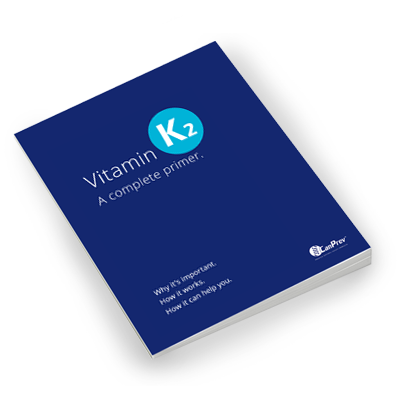

Throughout this primer, we’ve discussed many differences between vitamin K1 and K2. We’ve also mentioned two common forms of vitamin K2 – MK-4 and MK-7. These three forms, vitamin K1, K2 MK-4 and K2 MK-7, are the most common kinds of vitamin K supplements on the market.
But which one is the best form to take?
Here’s the short answer. Based on our latest understanding of vitamin K2 in the body with the latest research, the best form to supplement with is the MK-7 form of vitamin K2.
To understand why, let’s revisit some of these differences.
If you’ve read this far, you should have a good appreciation for how different vitamins K1 and K2 are. While vitamin K1’s primary role is blood coagulation, vitamin K2 is better for general health, due to its ability to better activate vitamin K-dependent proteins like matrix Gla protein and osteocalcin throughout the body. This allows it to support a wide range of biological functions like bone building and cardiovascular health.
Research supports this difference in roles. For example in the large scale Rotterdam Study, despite K1 intakes eight times higher than K2, only K2 demonstrated an inverse correlation to cardiovascular disease risk and aortic calcification.
Vitamin K1 does have some effect on activating VKDPs like osteocalcin. However the big difference is in the doses required. Studies that show vitamin K1 affecting the carboxylation of osteocalcin use doses in the range of 1 to 45mg per day, whereas MK-7 does the same at doses as low as 100 micrograms. At equal doses, MK-7 is three times better at carboxylating osteocalcin compared to K1.
Part of that reason is that K2 MK-7 has a much longer lifespan (or bioactivity) in the body than K1. Typically K2 MK-7 has a half-life of 72 hours. K1 only stays in circulation for a few hours before being flushed from the body.
Lastly, dietary sources of K2 are scarcer than that of K1. K1 is easily found in green leafy vegetables like kale, collard greens and spinach. Good dietary sources of K2 such as animal products from pasture raised livestock and fermented foods are harder to include in meals on a regular basis. So most adults are not K1 deficient, but there is a higher risk of being K2 deficient.

While MK-4 and MK-7 are both forms of vitamin K2, in terms of bioactivity and lifespan, MK-4 is more like K1 than it is like MK-7.
For one, MK-4 has an extremely short life-span. MK-7 can linger in the blood for days. MK-4? It has a half-life of only 1.5 hours.
In fact a 2012 Japanese dose comparison study comparing MK-4 and MK-7 blood levels after ingestion, researchers had difficulty detecting any amount of MK-4 in blood serum at any time point during the test!

Single 420mcg dose of MK-4 or MK-7 was administered to healthy subjects with a standard breakfast. While MK-7 reached maximal serum levels 6 hours after intake and was detected up to 48 hours later, MK-4 was not detectable in blood serum of all subjects at any time point. (Sato 2012)
It seems like most of the MK-4 is taken up by our tissues quickly after consumption but does not circulate for long in the blood. This makes it difficult to build up and accumulate a stable level of vitamin K your blood. To get the same consistent level of a single dose of MK-7, you may need to supplement multiple times with MK-4.

Increased serum vitamin K2 levels in subjects after 7 days of consecutive administration (60 μg/day) (Sato 2012)
“Sure”, you might say, “but just because MK-4 is undetected in blood tests doesn’t mean it is less effective in the body.”
You would be absolutely right to question that. As we mentioned earlier, a vitamin K blood test would only measure recent intake rather than a long-term nutritional status. And we don’t know how long MK-4 is stored in tissues and other organs in the body. But we can test long-term nutritional status based on how well each form activates VKDPs in the body.
A 2005 Japanese study looked at this issue exactly, trying to determine the minimum effective dose of MK-4 for affecting levels of activated osteocalcin in blood. Researchers started by administering 500mcg per day of MK-4 over a period of 2 months. However, there was no effect on the status of osteocalcin carboxylation. Only after administering an intake of 1500mcg per day of MK-4 was there an observable improvement in carboxylation status. By contrast, MK-7 has been shown to carboxylate osteocalcin with as little as a 45 to 90 mcg daily dose.
One of the main reasons that MK-7 circulates in the body longer than K1 or MK-4 is that it is more fat-soluble and therefore circulates in longer lasting low-density lipoproteins (LDL). LDL circulates in blood considerably longer than its bigger cousins like chylomicron and VLDL, which carry all three forms of K.
LDL transport may be the reason why MK-7 is so biologically effective at carboxylating osteocalcin in bone. It’s been demonstrated that in cell cultures, osteoblasts readily absorb vitamin K from LDL fractions.
To complicate matters, even if a molecule has exactly the same atoms, they may be put together in different ways. This is called isomerism and happens all the time in nature. K2 MK-7 molecules commonly exhibit a type of isomerism called cis-trans isomerism.
Cis-trans isomerism, also known as geometric isomerism, happens when functional groups in a molecule are rotated or bent into a different orientation. Shape is very important for coenzymes like vitamin K to work properly. Enzyme molecules like VKDPs are amino acid sequences folded into very specific shapes. In order for a coenzyme like vitamin K2 to fit and interact with these molecules, they must maintain a specific shape.
 If this shape is not quite right, it may slow down the activation of an enzyme or stop it completely. The easiest way to think of this is to imagine a lock and key. A straight key will fit the lock perfectly. A slightly bent key will need to be jiggled to get it to fit.
If this shape is not quite right, it may slow down the activation of an enzyme or stop it completely. The easiest way to think of this is to imagine a lock and key. A straight key will fit the lock perfectly. A slightly bent key will need to be jiggled to get it to fit.
The type of K2 MK-7 isomer that activates VKDPs are trans-isomers. MK-7 cis-isomers have a bend in their carbon chain and do not readily activate VKDPs. Since trans-isomer MK-7 are more readily used by our body, they are considered more bioactive. Many K2 ingredients have a mixture of cis and trans isomers, depending on how well they are produced. You’ll want to look for K2 supplements with a high percentage of trans-isomer MK-7, ideally 100%.
When we selected the K2 MK-7 to use in our products, we made sure to choose a form that was 100% alltrans. In fact, the ingredient we use is the United States Pharmacopeia (USP) standard, which is used to benchmark all K2 MK-7 ingredients for identity, quality and cis/trans purity!

There are two main ways to produce MK-7: fermentation and organic synthesis.
The fermentation method stimulates bacteria to produce MK-7 from a culture of soybean powder. After a period of time, this fermentation is filtered and the MK-7 is extracted and purified using solvents.
Organic synthesis is a proprietary method that begins with flower extracts farnesol and geraniol. Through a series of reactions it results in a pure all-trans form of menaquinone-7.
So, which method is better?
As long as the processes have high levels of quality control, both will result in a MK-7 molecule that is chemically identical. This was clinically studied. Two batches of all-trans MK-7, one produced by fermentation and the other by organic synthesis, had the same half-life and the same osteocalcin carboxylating activity in the body.
There are a few benefits of going with an organic synthesis produced MK-7. Those who have a sensitivity to soy may prefer to take an MK-7 produced by organic synthesis, as no soy is used. There’s also a chance that fermented MK-7 may have a mixture of cis and trans if the purification step is not rigorous.
The primary thing to look for in your K2 MK-7 is that it has a high ratio of trans isomers.
Necessary cookies are absolutely essential for the website to function properly. This category only includes cookies that ensures basic functionalities and security features of the website. These cookies do not store any personal information.
Any cookies that may not be particularly necessary for the website to function and is used specifically to collect user personal data via analytics, ads, other embedded contents are termed as non-necessary cookies. It is mandatory to procure user consent prior to running these cookies on your website.
Analytics cookies help us understand how our visitors interact with the website. It helps us understand the number of visitors, where the visitors are coming from, and the pages they navigate. The cookies collect this data and are reported anonymously.
These cookies collect information about how visitors use a website, for instance, which pages visitors go to most often, and if they get error messages from web pages. These cookies don’t collect information that identifies a visitor.
The “Other” category cookies help us provide our visitors proper functionality of the website such as online quizzes or embedded videos.
Advertisement cookies help us provide our visitors with relevant ads and marketing campaigns.
Learn about how vitamin K2 works, why it’s important, and how it can help you.
